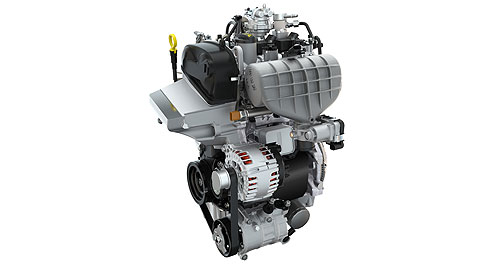Make / Model Search
News - VolkswagenVolkswagen details 200kW three-potPower of twelve: Volkswagen Groups new-generation W12 engine could find its way into a number of models, including the forthcoming Bentley Bentayga SUV. Powerful three-cylinder petrol, revised W12 headline Volkswagen's latest engine tech12 May 2015 UPDATED: 19/05/2015VOLKSWAGEN Group has announced details of its latest powertrain developments that include a 200kW three-cylinder TSI petrol engine, a higher-revving TDI diesel and tweaks to its W12 unit for ultra-luxury models. Detailing the technology at the Vienna Motor Symposium this month, the European automotive giant emphasised that optimisation of the internal combustion engine remained a key area of innovation as the industry responded to the need for more environmentally friendly mobility. “Climate protection is an integral part of our responsibility towards people and society,” said Volkswagen AG board member and head of powertrain development Heinz-Jakob Neusser. “Moreover, customers demand models with reduced consumption and lower emissions, and politics also makes high demands on the automotive industry.” Dr Neusser said the company was pushing ahead with development of its TDI diesel and TSI/TFSI petrol engines, typically in concert with its DSG dual-clutch automatic transmission. “High-efficiency TDI and TSI/TFSI engines – ideally in combination with DSG – will remain indispensable for the foreseeable future,” he said. “The reduction of CO2 emissions from internal combustion engines is pure hi-tech nowadays. Examples of this are our high-rpm diesel as well as the high-performance three-cylinder TSI engine.” The 1.0-litre three-cylinder TSI petrol engine is based on the EA211 engine family and capable of pumping out 200kW of power and 270Nm of torque. The powerful triple features a monoscroll turbocharger and an “e-booster” – and, according to Volkswagen, carries the genes of the Polo WRC’s rally engine. VW did not detail which model would first use the 1.0-litre turbo. The just-launched Polo GTI is powered by a 141kW/390Nm 1.8-litre inline four-cylinder turbocharged unit, while the Golf GTI uses a 162kW/350Nm 2.0-litre four-cylinder engine. The newly developed EU6-compliant 2.0-litre TDI turbo-diesel, meanwhile, will debut in the new-generation Transporter and Multivan, offering fuel economy improvements of up to 14 per cent and, on high-grade models, carrying a dual-stage turbocharger layout. For now, four versions of the engine are available, covering a power range of 62kW to 150kW and a torque range of 220-450Nm. As well as using a common-rail system with 2000 bar injection pressure, the 2.0 TDI 4V engine has a new low-temperature/high-pressure exhaust gas recirculation system and a water-cooled charge air cooler. VW says the inclusion of a variable intake manifold guarantees the necessary flow swirl when running at partial load, while exhaust gas after-treatment is accomplished by an oxidation catalyst with a downstream combination of diesel particulate filter and SCR catalytic converter. Dr Neusser said the high-rpm diesel “points the way to the future of the internal combustion engine in many respects”. He highlighted its “high-efficiency combustion methods, innovative thermal management, maximal charging thanks to e-boosters as well as new materials and coatings”. The other highlight at the symposium was the VW Group’s next-generation W12 engine, the current version of which is found under the bonnet of various Bentley models as well as the VW Phaeton limo and a limited-edition version of the Audi A8. Engineers have combined Audi’s FSI direct injection and Bentley’s TMPI multi-point injection system for the new version of the W12, while other changes include the use of an oil circuit suitable for off-road use, which will come in handy if, as reports suggest, the engine is used in the forthcoming Bentley Bentayga SUV. VW claims the changes have led to the most economical 12-cylinder engine in the luxury segment. It says the 447kW/900Nm 6.0-litre can hit 100km/h in less than four seconds, reach a top speed of more than 300km/h, and return CO2 emissions of 250g/km – although it did not specify which vehicle was used for these benchmarks. Other new tech detailed at the event included a new coating technique called ‘laser roughening’ which will soon be used in production to minimise engine friction and increase performance.  Read more |
Click to shareVolkswagen articlesResearch Volkswagen Motor industry news |











Facebook Twitter Instagram